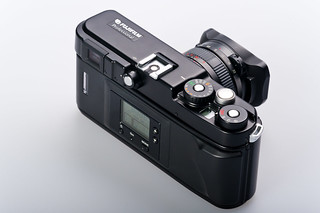Fujifilm TX-1
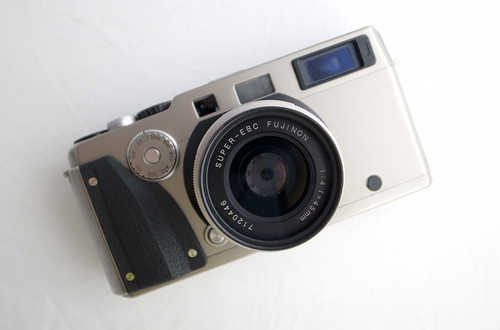
|
| Fujifilm TX-1 image by Bellamy Hunt (Image rights) |
The Fujifilm TX-1 is a interchangeable lens 35mm panoramic rangefinder camera released in 1998. It was manufactured by Fujifilm as a joint project with Swedish camera maker Hasselblad who markets the camera under the branding XPan.
The body is made from titanium and aluminium. The back of the camera is covered by a rubberized material and has a good thumb grip for the right hand. TX-1 are common in a silver colour, while the XPan in a painted black. Wood and rubberized front hand grips have been produced, and are often swapped with one another. Home made and third party wood grips have also been manufactured.
It was designed as a coupled rangefinder camera system with interchangeable lenses. Three lenses were released upon introduction. A 45mm f/4, a 90mm f/4 and a 30mm f/5.6 which requires a external viewfinder. The built-in viewfinder has automatic parallax compensation with bright lines that automatically change depending on the lens mounted and format used. Focusing is done on the barrel of the lens which is coupled to the rangefinder. The rangefinder focusing device can be seen as a rectangular patch in the viewfinder. The camera back contains a LCD screen showing various camera settings like ISO, battery level check, self-timer, etc.
It uses a focal plane shutter, with speeds of 8 sec to 1/1000 sec. Flash sync is at 1/125s. plus a B mode. The available electronic self timer feature has a 10 sec delay. The light meter is a TTL center-weighted averaging type. The meter is set with Auto DX encoded films, but can also be set manually with either non-coded or speed overridden DX film. There are two shooting modes, aperture priority and manual exposure modes. In both exposure modes, the light meter indicators in the viewfinder can aid in exposure by displaying − for under exposure, o (circle) for correct exposure and + for overexposure. The shutter speed is displayed on the back LCD. TV will flash if the shutter is incapable of compensating for the amount of light or aperture setting. Exposure compensation is available from ±2 EV in ½ steps. An auto exposure bracketing features is also available.
Images can be captured on 35mm film in two different sized formats. A conventional 24×36mm size and a panoramic 24×65mm. The format setting can be changed anytime even mid-roll. In panoramic format it is able to approx expose 21(20) images onto 36 exposure rolls, 13 on 24 and 6 on 12 exposure rolls. Initial film loading takes longer compared to most cameras. The film is completely unloaded onto the spool and the film is shot back into the film canister. This is because of different length films and the ability to switch formats mid-roll. The exposures are counted downward indicating the number of frames remaining. Changing format updates the counter. There are two modes of automatic motor drive film advance, single and consective modes. C mode can capture at 3fps in standard and 2fps in panorama format. There is a counter that keeps track of the number of exposures. To access with the camera off, press and hold AEB and change the shooting mode to S. Each unit represents 10 exposures so 56 is 560 exposures. The camera requires 6 volts of power from two CR2 lithium batteries.
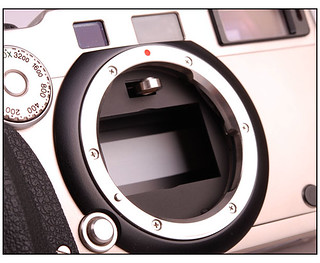
|
| image by RickC (Image rights) |
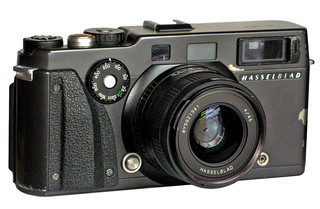
|
| Hasselblad version image by Romuald Swieconek (Image rights) |
TX-2
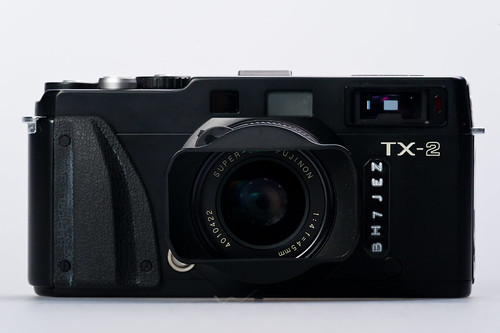
|
| TX-2 front view image by Calvin Chan (Image rights) |
The Fujifilm TX-2 was announced in 2003 as a minor revision of the TX-1. It is also known as the Hasselblad XPan II. The first noticeable change is the absence of the large ISO dial on the front of the camera. The setting has been moved to the back LCD screen. This was changed because this knob is easily rotate by mistake when not locked on DX. The exposure compensation dial is no longer on the power / motor drive dial. It too has moved to the LCD back. It adds a few features like shutter speed exposure information in the finder, 2 second self timer, leader out film rewinding, flash sync at start or end of exposure, and multiple exposure control. The bulb mode can now open for 9 minutes, but this is electronic and so it uses up battery power. The seals have been redone and there is now less fogging for IR films. The bodies are commonly available in black.
|
|
Issues
Painting onto titanium has always been a difficult process. Paint does not adhere to titanium as well as other metals. As a result black painted cameras tend have areas of paint chipping.
